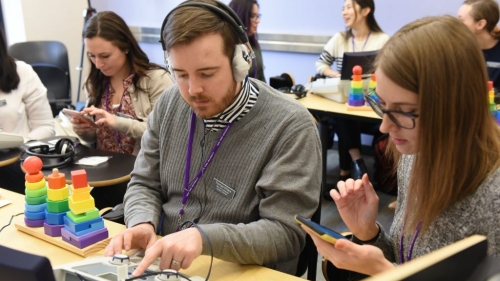Researchers at the Steinhardt Language Experience and Acquisition Research at NYU (LEARN) Lab collaborated with a local illustrator to create a series of whimsical videos providing research-based advice for children’s caregivers.

Can singing to babies help expand their vocabularies? What kinds of toys and games encourage early literacy skills? Do babies understand what you’re saying, even if they’re pre-verbal?
In Associate Professor Sudha Arunachalam’s experience, caregivers of infants and children are eager to learn accurate information about supporting young children’s language development. However, with a pandemic limiting in-person outreach with families at Dr. Arunachalam’s LEARN Lab, part of the NYU Steinhardt Department of Communicative Sciences and Disorders, her team pivoted to a new approach to disseminate this sought-after information to families.
Working with local illustrator Tamisha Anthony, the LEARN Lab created a series of ten animated “Quick Tips” videos sharing practical, research-based advice—in both English and Spanish—to guide caregivers in developing their children’s language skills and school-readiness. The lively, under-a-minute videos feature a cast of illustrated characters designed to capture the attention of adults and children alike.
We caught up with Dr. Arunachalam to learn more about the project and what makes these videos a unique resource for families.
What inspired you to create these videos?
My lab does a lot of outreach activities, speaking to families about language and language development. My experiences with this have been that caregivers are hungry for information about how to support their children's development, and also that there are many misconceptions out there that can leave caregivers frustrated and confused. Because our normal outreach activities have been curtailed by the pandemic, I thought this would be a good opportunity to create something that could reach a larger audience.
What makes these videos unique?
While there are lots of resources out there for caregivers, many of them require a large time investment, like taking a full course, and many others are misleading or contain poor information. I wanted to address some of the most common questions I am asked by caregivers in a fun, lighthearted, and quick way, and all of the ideas in the videos are based in a solid body of scientific research.
In your view, why was incorporating illustrations an important part of the project?
I wanted the videos to be eye-catching and engaging. I also wanted them to appeal to young children; a caregiver could watch them with their baby while waiting in line at the store, for example, or at the doctor's office. Tamisha decided to use shapes in bold colors as the characters so that caregivers could also talk with their babies about colors and shapes.
What is the biggest lesson you hope caregivers take away from the videos?
Learning a language or languages is one of the most amazing things babies do in their first years of life. Caregivers support language development just by talking (or signing) and interacting in everyday situations.
Is there anything else about the project you'd like to share?
I'm really proud of the fact that the videos are in both English and Spanish. We may consider including other languages in the future as well. My lab managers, Melanie Lopez Perez and Taylor Boyd, were also a huge part of this endeavor. Melanie deserves special credit for creating the Spanish versions of the audio and text.
View the Quick Tips Video Series
For more practical advice from the LEARN Lab, watch the full set of videos available in both English and Spanish.
Watch MoreRelated Department

Communicative Sciences and Disorders
665 Broadway, 9th floor
New York, NY 10012
Phone: 212-998-5230

